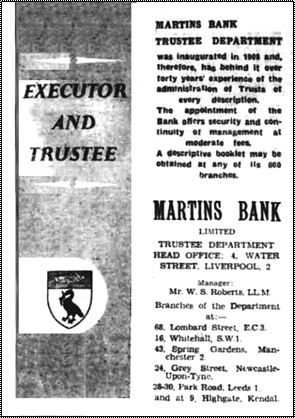|




Image © Martins
Bank Archive Collections
|

In Service 1908 to 21 November 1969



 Martins Bank is justifiably proud of its regional
structure, local branches, local head office departments, and the quick
decisions that can be made to help customers, based on local
knowledge. It comes as no surprise
then, to find that the Bank’s Trustee and Investment and Income Tax
Departments can also be found, arranged in a similar way, covering England
and Wales, The Isle of Man and the Channel islands. The first of the Trustee
Departments is established in 1908 by the Bank of Liverpool. Sixty years later
Martins Bank combines that business with regional Income Tax and Investment
Offices to create MARTINS
BANK TRUST COMPANY LIMITED. We
were delighted to be provided with an insight into what what life was like
for the staff of the Liverpool Trustee department in the late 1940s / early
1950s, from Friend of the Archive Derek Lucas who wrote to us about his own
time there. Martins Bank is justifiably proud of its regional
structure, local branches, local head office departments, and the quick
decisions that can be made to help customers, based on local
knowledge. It comes as no surprise
then, to find that the Bank’s Trustee and Investment and Income Tax
Departments can also be found, arranged in a similar way, covering England
and Wales, The Isle of Man and the Channel islands. The first of the Trustee
Departments is established in 1908 by the Bank of Liverpool. Sixty years later
Martins Bank combines that business with regional Income Tax and Investment
Offices to create MARTINS
BANK TRUST COMPANY LIMITED. We
were delighted to be provided with an insight into what what life was like
for the staff of the Liverpool Trustee department in the late 1940s / early
1950s, from Friend of the Archive Derek Lucas who wrote to us about his own
time there.


|
|
It
would appear to have been not so much a behind the scenes environment, as a
quiet backwater from which you really had to try hard to escape, if you
wanted to get on elsewhere in the Bank…

  “I was nine years at Water Street in the bank's Head Office Trustee
Department, along with, soon after rejoining the Bank after war service,
several clerks of my age. I was assigned to the Securities Desk and it soon
became apparent that the Bank dealt with numerous and very rich settlements
founded by very well-known Liverpool families. In addition, more and more
will appointments meant that the Bank had to have a comprehensive service
throughout the country and branches had been established to this end. All
went well, it was quite exciting to be working in Head Office, even if you were
on the fourth floor, but you were where things happened and not in some
remote Branch. “I was nine years at Water Street in the bank's Head Office Trustee
Department, along with, soon after rejoining the Bank after war service,
several clerks of my age. I was assigned to the Securities Desk and it soon
became apparent that the Bank dealt with numerous and very rich settlements
founded by very well-known Liverpool families. In addition, more and more
will appointments meant that the Bank had to have a comprehensive service
throughout the country and branches had been established to this end. All
went well, it was quite exciting to be working in Head Office, even if you were
on the fourth floor, but you were where things happened and not in some
remote Branch.

 However, time passed and by the fifth year one came to realise this career path was in reality a “cul-de-sac”. The Department had three signing officers,
an Assistant Manager, a Sub-Manager
and the Manager, six in
all. I must say the
staff were very happy up to a point, but we hadn't joined the Bank to be
Executors and Trustees. All our contemporaries were gaining valuable
experience in Branch banking which would lead in many cases to promotion and
to the higher echelons of Management. However, time passed and by the fifth year one came to realise this career path was in reality a “cul-de-sac”. The Department had three signing officers,
an Assistant Manager, a Sub-Manager
and the Manager, six in
all. I must say the
staff were very happy up to a point, but we hadn't joined the Bank to be
Executors and Trustees. All our contemporaries were gaining valuable
experience in Branch banking which would lead in many cases to promotion and
to the higher echelons of Management.
Along with some others with similar views it took several years to be extricated
from this 'backwater' and on rejoining the mainstream of branch banking
several years of intensive activity to get and keep abreast of those luckier
enough to have had a head start, as it were. I don't intend to sound just an old sour grape, but a huge
number of staff must have had the same experience and indeed the Staff
Turnover must have gathered pace in the fifties and early sixties. These departments should have attracted
recruits from the professions, such as the law and accountancy, a worthwhile
experience for any young trainee solicitor or trainee accountant. The lack of
appointments, compared to the expansion of the Branch Network, meant that you
were placed in a backwater, in some cases for life, no pun intended. If that all sounds very pessimistic
I apologise, but being the biggest separate department, outside of the Branch
Network, there must surely be a case for it and its records to join Martins Bank Archive”…

|





















